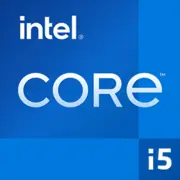Intel Core i5-11500H

Intel Core i5-11500H: A Balance of Power and Mobility in 2025
April 2025
Despite being released back in 2021, the Intel Core i5-11500H remains a relevant option for budget and mid-range laptops in 2025. This processor offers sufficient performance for most tasks, moderate power consumption, and an affordable price. Let’s explore who it is suitable for today and how it stands against modern competitors.
Architecture and Process Technology: 10 nm SuperFin and Hybrid Technologies
The Intel Core i5-11500H belongs to the Tiger Lake-H generation, which marked an important step for the company in the fight for energy efficiency.
Key Specifications
- Process Technology: 10 nm SuperFin – an improved version of the 10-nanometer technology that has reduced power consumption and increased clock speeds.
- Cores and Threads: 6 cores, 12 threads. Unlike the top models in the H45 series (e.g., i7-11800H), it lacks additional efficient cores — all cores are identical (monolithic architecture).
- Clock Speeds: Base – 2.9 GHz, maximum in Turbo Boost – 4.6 GHz. In multi-threaded tasks, the processor reliably maintains around 4.2 GHz with good cooling.
- Cache: L3 – 12 MB, which is sufficient for data processing in games and professional applications.
Integrated Graphics
The integrated GPU is Intel UHD Graphics for the 11th generation (Xe-LP with 32 EUs). This is a significant step forward compared to previous generations:
- Support for DirectX 12, HDMI 2.0, DisplayPort 1.4.
- Capability to output to 4K monitors at 60 Hz.
- Gaming performance: CS:GO – 50-60 FPS on medium settings (1080p), GTA V – 30-40 FPS (low settings).
Architectural Features:
- Support for PCIe 4.0 (up to 20 lanes) – relevant for fast NVMe storage.
- Thunderbolt 4 and Wi-Fi 6 (Gig+) – standards that remain in demand in 2025.
Power Consumption and TDP: A Balance of Power and Longevity
The nominal TDP of the processor is 35 W, but in reality, it can consume up to 45-50 W under peak loads (for example, during gaming or rendering). This imposes demands on the laptop's cooling system:
- Thin Ultrabooks (e.g., Dell XPS 15 9520) with passive cooling may limit performance to reduce temperature.
- Gaming and Work Laptops (Acer Nitro 5, Lenovo Legion 5) with active coolers allow the processor to operate at maximum frequencies for longer.
Tip: When purchasing, pay attention to the thickness of the chassis and the number of ventilation holes. For example, laptops with the i5-11500H in a chassis less than 18 mm thick often overheat.
Performance: From Office to Gaming
Office Tasks and Multimedia
- Geekbench 6: 1894 (single-core), 6388 (multi-core). This level is sufficient for working with large Excel spreadsheets, Photoshop, and 4K video in Premiere Pro (with discrete graphics).
- Real Tests:
- Rendering a 10-minute video in DaVinci Resolve (1080p): ~12 minutes.
- Running 20 tabs in Chrome + streaming YouTube: without lags.
Gaming
With a discrete graphics card (e.g., NVIDIA RTX 3050 Ti or AMD RX 6600M):
- Cyberpunk 2077: 50-60 FPS on medium settings (1080p).
- Elden Ring: 45-55 FPS (high settings).
Turbo Boost: In turbo mode, the processor maintains frequencies around 4.4–4.6 GHz for up to 30 seconds, which is useful for short bursts of load (level loading in games, opening heavy applications). However, in prolonged tasks (e.g., rendering), frequencies drop to 3.8–4.0 GHz.
Use Cases: Who is the i5-11500H Made For?
1. Students and Office Workers – multitasking, working with graphics and databases.
2. Budget Gamers – paired with a GPU like the RTX 3050.
3. Freelancers – video editing, 3D modeling (Blender, AutoCAD).
Example: The HP Victus 16 laptop (priced $700–800 in 2025) with an i5-11500H and RTX 3050 handles gaming and editing excellently.
Battery Life: How Long Does the Charge Last?
At a TDP of 35 W, battery life significantly varies with tasks:
- Web Browsing: 6–7 hours (brightness 50%, Wi-Fi).
- Gaming: 1.5–2 hours.
Power-saving Technologies:
- Intel Speed Shift – dynamic frequency management.
- Adaptix Dynamic Tuning – machine learning for load optimization.
Tip: In Windows settings, switch to “Battery Saver” mode to extend battery life by 20–30%.
Comparison with Competitors
AMD Ryzen 5 5600H (Zen 3, 7 nm)
- Pros: Better multi-threaded performance (~10% in Cinebench R23).
- Cons: Weaker in single-threaded tasks (Geekbench 6 Single Core – ~1700).
Apple M1
- Pros: Battery life (up to 15 hours), cool operation.
- Cons: Limited compatibility with Windows programs.
Conclusion: The i5-11500H excels over AMD in gaming due to its high single-threaded performance, but falls short in battery life.
Pros and Cons
Strengths:
- Excellent performance in games and single-threaded tasks.
- Support for modern standards (PCIe 4.0, Thunderbolt 4).
- Affordable laptop prices ($600–900).
Weaknesses:
- High power consumption under load.
- Integrated graphics are weaker than those of the Ryzen 5 5600H (Vega 7).
Recommendations for Choosing a Laptop
1. Gaming Laptop: Look for models with RTX 3050/3060 and a 144 Hz display (e.g., Lenovo Legion 5 – $850).
2. Workstation: At least 16+ GB of RAM and 1 TB SSD (MSI Creator M16 – $950).
3. Versatile Option: Laptops with a 15–16 inch screen and a 70+ Wh battery (Asus VivoBook Pro 15 – $750).
Important: Ensure the laptop has at least 2 fans and 3 heat pipes.
Final Conclusion
The Intel Core i5-11500H in 2025 is an excellent choice for those seeking an affordable yet powerful laptop for gaming, work, and creativity. Its key advantages include:
- Strong single-threaded performance.
- Support for current connectivity standards.
- Optimal pricing.
It's suitable for:
- Gamers with a budget under $1000.
- Freelancers working with graphics.
- Students needing a versatile device.
If battery life is more important to you than power, consider laptops with the Apple M2 or AMD Ryzen 7 6800U.
Basic
CPU Specifications
Memory Specifications
GPU Specifications
Miscellaneous
Benchmarks
Compared to Other CPU
Share in social media
Or Link To Us
<a href="https://cputronic.com/en/cpu/intel-core-i5-11500h" target="_blank">Intel Core i5-11500H</a>